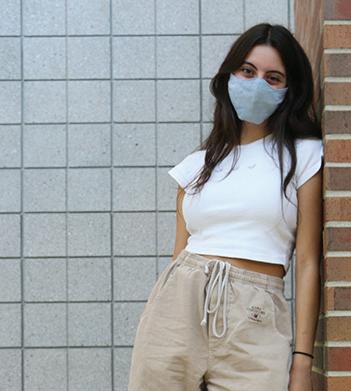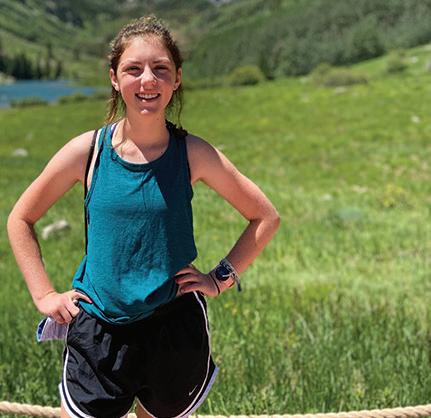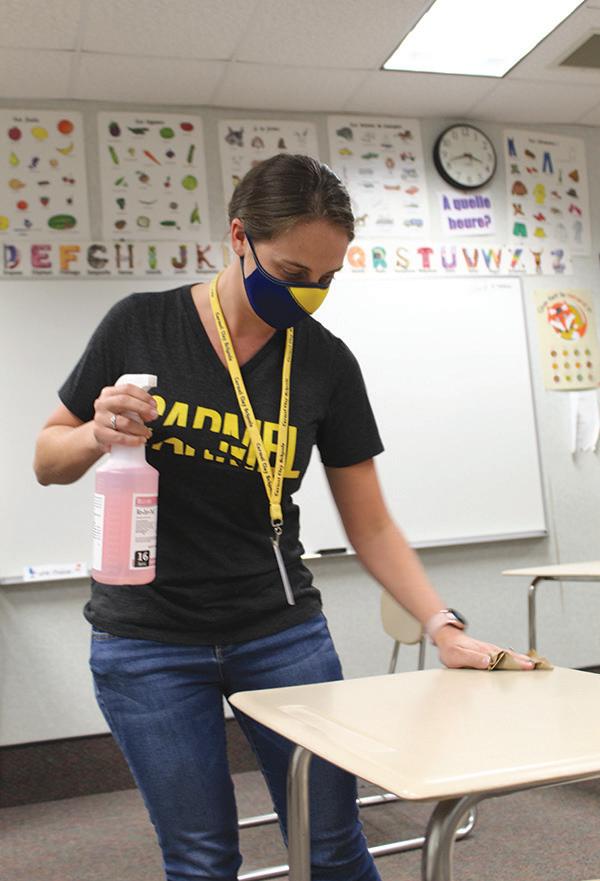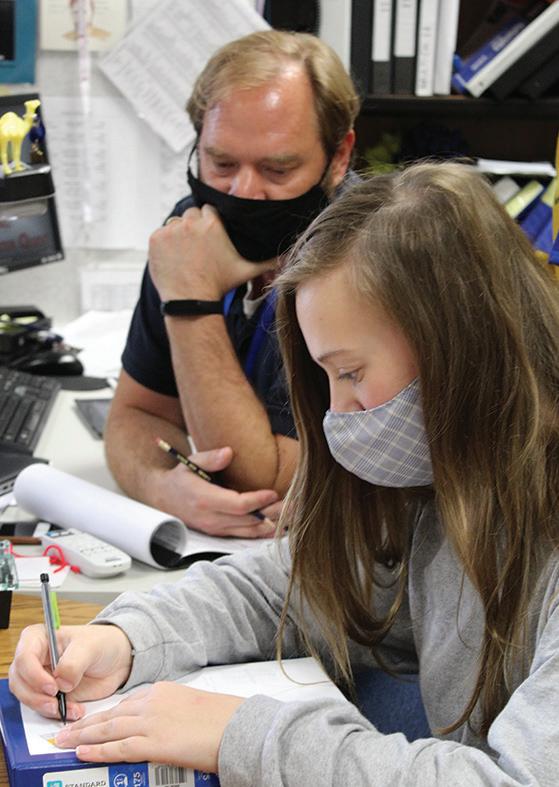
15 minute read
HUMANS OF CHS
Celebrating self improvement month, students, staff tell experiences of personal growth
This Q&A was originally published online on Sept. 16, 2020
Advertisement
WENDY ZHU Q&A, PHOTOS
sophomore sydney perez
I’m just trying to improve my work ethic. I have a planner where I write down everything I need to get done and due dates. I’ve had this goal throughout high school. With all this online stuff, I guess it’s just harder to do it at home because
I don’t have as much motivation as I do at school, and I just don’t feel like doing it at home.

food service worker debbie brown My self-improvement goal is to lose weight. I gained a lot of weight during the pandemic, and now I’m on my toes losing weight. I’m down eight pounds (so far). I’m not on any specific meal plans, just watching what I eat and just making sure I walk at least 15 to 30 minutes a day.


senior mackenzie webster I’m working to establish deadlines and basically just prove to myself and others that
I can do it. I’ve been thinking about this for a while, trying to build up things that I could use for when I do apply (to college) senior year. When I applied to be a GKOM, I thought about how it could help me with (college) applications, and (I got) a job so I could show that I kept my grades and maintained responsibility
GRACE SULLIVAN SUBMITTED PHOTO


junior grace sullivan This year, I’m really just trying to stay on top of my academics, especially for applying to future colleges that I’m looking at. I’m going in to see my teachers more often— especially this year, I feel like it’s so important to form a bond with your teachers while you’re there because you only see them once a week, maybe twice. I’m also just trying to be present and not on my phone as much.

senior bradley snyder I definitely want to get more sleep. I want to try to make a more conscious effort to go to bed earlier and also drink less caffeine in the evenings so I can fall asleep at night. When I don’t get enough sleep, I am very groggy throughout the day, and it makes it harder to get stuff done when I come home from school when I’m very tired. Getting enough sleep would definitely make me able to get more work done throughout the entire day. Junior year,
I made a more conscious effort to get more sleep, and junior year was better than the first two (years of highschool), but I’m hoping senior year will be the best.
ABOVE &
With additional COVID-19 regulations, staff members find themselves working harder during school hours
ANIKET BISWAL, ARCHIT KALRA STORY

KIERSTEN RIEDFORD SPEAK-UPS, PHOTOS
BEYOND


Before covid-19 shut this school down in March, French teacher Lisa Carroll already had her lessons planned out for the upcoming year. She knew she could use materials from past years to help her teach concepts to students intent on learning.
However, with the new challenges in this school year, Carroll said she can no longer rely on past materials; instead, she said she needs to create short videos for virtual learners as well as update her Canvas structure with modified lessons. Because of all these changes, she said she is doing more work than ever in the past.
According to Carroll, many teachers are feeling overwhelmed because of the new routine and structure.
“In March, when we went fully online, it was a huge upheaval on how I conduct everyday lessons and classes,” she said. “Also, only seeing my students once a week instead of two or three times has been a big difference on how I teach.” “The main challenge for teachers now is creating the online materials. Many teachers I talk to have said, ‘I feel like a first-year teacher again,’ so it feels like we are starting over again,” she added. “This has added a whole new plate of planning and prep work, plus a little bit of stress.”
Social studies teacher Sandy
Gardner had a similar sentiment.
She said, “Teachers are definitely working harder, even harder than the spring. We are doing virtual work and in-class work so it is double (the amount of work).”
Sophomore Cate Beck, whose father Peter Beck teaches mathematics at CHS, said she does not see her father as often because of his extra virtual work.
“His schedule is always full between helping around the house and driving us kids around to activities when he’s not in a (Zoom) call,” she said.
Because of the added work pressures on Mr. Beck, Cate said she helps support her father by helping with her younger siblings.
“I have been helping by watching my younger siblings so that my dad can get his work done and not be interrupted during (Zoom) calls,” she said.
In late July, a national poll from NPR/Ipsos found that 66% of teachers preferred a virtual learning environment rather than an inperson or hybrid one.
Carroll said there have been some mixed opinions from CHS teachers on opening school. Furthermore, she said the staff has become more aware of the potential risks associated with not following the guidelines properly.
BY THE NUMBERS 45 St. Vincent Wellness Center CHS staff members 94 CHS special services staff members 2.5 MILLION janitors in the United States 689 staff members employed at CHS 466 virtual CHS students
CCS, U.S. BUREAU OF STATISTICS SOURCES “We’ve had to rearrange how we manage the clinic; for instance, we’ve had to come up with how we can isolate students. We would have been ready to do it before but now we can take care of more isolated cases (with the remodeling of the office). It has definitely affected our patient care.”
Amy Fletchall, Registered Nurse
“I feel like teachers in general are doing a good job with maintaining the guidelines sent to us about keeping students safe, but there are some teachers who are more concerned due to underlying conditions than others,” Carroll said. “However, I feel that all teachers are aware that our actions affect more people than just us. Because of that, I am much more cautious in my personal life knowing that I’m exposed to over 120 students each week.”
However, the pandemic has not only impacted the learning environment. Lori Vohs, assistant food service manager at Greyhound Station, said there has also been a substantial increase in her workload because of the changes to protocol. Specifically, she said the cafeteria staff now individually bags and wraps all of the food they prepare.
“I don’t know if (the administration) really realizes how much work it is to bag the food,” Vohs said. “I think (the administrators) know what’s going on, but some days you’re just like, ‘Ugh.’ It is a lot of work, and I don’t know if (people) realize sometimes how much work it actually is, to remember what’s in what bag, to make sure everything’s labeled, that sort of thing.”
Vohs also said there are difficulties in keeping up with the work-
PROTECTIVE MEASURES The custodial staff is Janitors carry See what materials staff members use to keep students healthy during COVID-19 equipped with chemimops and brooms cal cleaners that help to clean dirty ar
Lunch workers Lunchrooms are employdisinfect surfaces eas of the school wear masks ing a grab-and-go system The cafeteria staff bags indiand gloves to avoid spreading germs Many schools are providing more free for students to quickly get their lunches to avoid excessive contact Custodians are usually briefed on a plan and schedule de veloped by Staff keeps replace able products like toilet paper, paper towels, hand sanitizer and wipes vidual foods to keep food safe or reduced lunches for families in need administrators so they can clean regularly The custodial staff take precautions since they are exposed to more The staff is germs and viruses required to consistently wipe down and sanitize tables SOWMYA CHUNDI GRAPHIC CLEANLINK, CDC SOURCES
SECONDS SPENT:
(LEFT) French teacher Lisa Carroll sprays desks and wipes them down after her final class. Carroll said the most difficult part of working so hard is the feeling of exhaustion. (BELOW) Peter Beck (left) helps his daughter, sophomore Cate Beck (right), with her homework. Cate said since her father has been working more at home, it has been hard for their family to have quality time with him lately.

MADDIE MISTERKA PHOTOS

load because there are fewer cafeteria staff members this year.
“(My staff) shrank down because they took people out of my kitchen and they have moved them to elementary schools,” she said. “I work a line every day—I’m out there completely— and there’s just no time. And when the kids come, they come fast, and they want their food, and you’re like, ‘Ahh!’”
In regard to students, Vohs said while students have been actively socially distancing to the best of their ability, it has still been difficult to enforce the rule in lunch lines.
“Even on the first day, (with) the (hand) sanitizer, you can try your
BY THE NUMBERS 5,127 students attend CHS both in-person and virtually 122 students attend CHS daily
CCS SOURCE best to get them to use it, but it’s just not (working),” she said. “The social distancing in the line is hard to manage. They do good out here, as far as sitting at the tables (socially distanced), but in the lines they just bunch up. They want to be together.”
However, both Vohs and Greyhound Station chef Karen Courter said they agreed students have been very vigilant in regard to wearing masks properly.
“I’m really happy how people are embracing the masks,” Courter said, referring to the recent trends displayed with masks. “It doesn’t bother a lot of people, and we just want to be back to normal and help the kids feel as comfortable as we can make them be.”
In general, Vohs said the overall protocol for cafeteria staff is not entirely new.
“Really as far as what we do, (the protocol) has not really changed,” she said. “We always wash our hands, wear our gloves, wear our aprons (and) we change the aprons. The only thing different is the mask, which sometimes gets difficult when it’s hot, but I think overall we’ve always been (using similar protocol).
“I think that the major issue is trying to make sure
everything’s in a bag,” Vohs added. “It’s less kids, but because you have to do that, it feels like a lot more work.”
Similarly, the custodial staff has had a general increase in workload since this school shut down in March. According to custodial supervisor Bob Hargis, custodians have had more cleaning requirements added on to their previous routine compared to past years.
Hargis said the custodial staff normally would clean the whole building every summer by wiping down walls and replacing broken or damaged parts of classrooms. He added they did all of these procedures this summer, but the staff also had additional regulations to follow when cleaning and repairing.

“We do all of that every summer, but in addition to that, this year we were using sterilizing equipment and sterilized everything inside every classroom,” Hargis said. “So it definitely added some work to our summer work. We also had to work around the construction that was happening.”
According to Hargis, another important change to the custodial staff was the addition of two new cafeterias, namely the media center and upper deck of the varsity gym. He said the custodians are assigned to each cafeteria; in the past, the custodians could “float around” and help one another. Because of this, according to Hargis, many situations regarding problems around the school, unless urgent, are being pushed later to fix.
MASKED UP:
(TOP) Cafeteria manager Holly HuepenbeckerHull speaks with cafeteria staff member Maria Arriaga Zavala about their weekends while working on packaging food for students. Cafeteria manager Lori Vohs, not pictured here, said conversing with the other staff members has been a highlight of spending more time working on students’ meals. (BOTTOM) Cafeteria staff member Debbie Brown (right) works on packaging meals with her coworkers, Kat Teter (left) and Karen Tompkins (middle). Brown said that while packaging the food takes a lot time, the work is worth it to ensure the safety of the hybrid students who are continuously coming into the school on their specific cohort days.
MADDIE MISTERKA PHOTOS

He said, “When a work order comes in, such as a teacher spilled something or a light switch is broken, we don’t have people to send to fix those problems, so it’s created a real challenge for us to keep the routine. If it’s not an emergency, we just do those work orders in the mornings, which has been helped by the later start times.”
Outside of school, Cate Beck said she and her family cannot do as many activities as they did before the pandemic because of the changes they have had to make to their routines due to her father’s work schedule.
“Because my dad has to work more and I have to help him more, we have less time to just relax and be able to spend time together like we were able to before COVID-19,” she said.
Gardner said the new changes have impacted how much time she has to spend with her family.
“We are careful, but we still live our lives by going (to) places as a family,” she said. “In terms of work, teaching has its own demands right now, but added to that is leaving two kids at home to do their virtual work. Sometimes it is difficult because when I get home from work, I have to help with the work that my kids have questions on.”
Carroll said the new schedule has blended some aspects of her work time and her personal time.
“Personally, I don’t take my work home with me after the school day is
FRENCH TEACHER LISA CARROLL
STAFF STATS
Take a look at the distribution of various staff members at CHS Lay Custodians/
Coaches Maintenance Administration Food Student Service Services Transportation
Instructors
Instructors (401) Transportation (147) Custodians (51) Maintenance (4) Student Services (81) Administration (14) Lay Coaches (46) Food Service (37)
CHLOE SUN GRAPHIC CCS SOURCE
done, but because of the extra work, I have to stay at school for longer hours,” she said. “Plus, I have my emails sent to my phone, so sometimes I get emails from teachers or students at home and I need to respond to them, so it feels like I am (at work) all the time.”
Gardner also said the new procedures have some consequences in terms of increasing the amount of student participation while in class with new peers and teachers.
“I want students to be more willing to talk to a new person, even
BY THE NUMBERS 552 jobs in cafeteria and food service are open in Indiana U.S. BUREAU OF STATISTICS SOURCE
SLOWING THE SPREAD
Take a look at some of the ways CHS is minimizing the spread of COVID-19
Students and staff must wear masks
OLIVIA STOCK, ASHWIN PRASAD GRAPHIC CCS SOURCE “I think the students have been cooperating (and appreciating us), and that’s a big deal; (the students) are doing a lot of the work. I think when I see the numbers go down on our results then it means that it’s actually working and that we’re doing the right things.”
Liz Cesare, Media Assistant
with a mask on,” she said. “Being in group work usually assists in getting students to know each other. The issue is trying to do that with social distancing.”
Carroll said she agreed with Gardner about the obstacles with new routines at school and added she finds the new procedures hinder students from learning and communicating the same teachers and mentors compared to previous years.
“With language learning, we have seen through research that the best way for students to learn it is through constant exposure and hearing it often,” Caroll said. “Added to that, SSRT is another challenge because (it is) only one session. Now, if my students need help or have trouble, they can only see me once a week for that, and if they have a pass for a different teacher, then it might be two weeks before they get their questions answered.”
With the new circumstances imposed by the pandemic, the staff also said they have felt more gratitude and appreciation from the student body as a whole.
“Personally, I think gratitude is always appreciated, no matter what or why,” Carroll said. “I actually had my students email all their teachers on the first day saying how much they appreciate their teachers’ hard work. It’s always nice when I see students who are flexible and patient whenever something happens because it’s almost like (us teachers) are reinventing the wheel.”
Vohs said she thinks the loss of social interaction between the students due to quarantine has been a factor in changing students’ perspectives on attending school.
“I think we’re trying harder this year to say hi to the kids, try to get into the world, try to talk to them more, say, ‘How’s your day going?’ say, ‘Have a good day,’” Vohs said. “I think they’re just happy to be here. I think the kids understand. They’re more grateful this year.” H
Desks, computers and shared supplies are sanitized after each use
Additional hand sanitizing stations were set up Only two people allowed per lunch table
There are two bells, one 30 seconds later for more space in the halls







